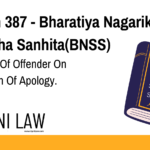Code
377.
(1) If a person is detained under the provisions of sub-section (2) of section 369, or section 374, and such Inspector-General or visitors shall certify that, in his or their judgment, he may be released without danger of his doing injury to himself or to any other person, the State Government may thereupon order him to be released, or to be detained in custody, or to be transferred to a public mental health establishment if he has not been already sent to such establishment; and, in case it orders him to be transferred to a public mental health establishment, may appoint a Commission, consisting of a Judicial and two medical officers.
(2) Such Commission shall make a formal inquiry into the state of mind of such person, take such evidence as is necessary, and shall report to the State Government, which may order his release or detention as it thinks fit.
Explanation of Section 377 BNSS
Section 377 of the Bharatiya Nagarik Suraksha Sanhita (BNSS) outlines the process for releasing a person with mental illness who has been detained in accordance with Section 369 or Section 374, once it is determined that they are no longer a threat to themselves or others.
The Inspector-General of Prisons or mental health visitors are responsible for certifying that the individual can be safely released. Based on this certification, the State Government may either order the person’s release or continue their detention. If the individual has not already been sent to a public mental health establishment, they may be transferred there.
In cases where the individual is to be transferred, a Commission consisting of a Judicial officer and two medical officers is appointed to formally inquire into the individual’s mental state. The Commission gathers evidence and submits a report to the State Government, which then decides on the release or continued detention of the person.
Illustration
Example 1: Release After Certification
A person with mental illness is detained under the provisions of Section 369. After a thorough assessment, the Inspector-General of Prisons certifies that the person no longer poses a risk to themselves or others. The State Government then orders the person’s release.
Example 2: Transfer to Public Mental Health Establishment
A person detained under Section 374 is found to still need care. The State Government decides to transfer the person to a public mental health establishment and appoints a Commission to evaluate the person’s mental state. The Commission reviews the evidence and submits its findings to the State Government, which then decides on the future course of action.
Common Questions and Answers on Section 377 BNSS
1. Who certifies if a person with mental illness can be safely released?
- Answer: The Inspector-General of Prisons or designated mental health visitors provide the certification stating whether the individual can be released without posing a danger to themselves or others.
2. What happens if the person is still not considered fit for release?
- Answer: If the person is still deemed a risk, they may either remain detained or be transferred to a public mental health establishment for further care and treatment.
3. What is the role of the Commission mentioned in Section 377?
- Answer: The Commission, consisting of a Judicial officer and two medical officers, conducts a formal inquiry into the person’s mental state. It then reports to the State Government, which decides whether to release or continue the detention of the person.
4. Can the State Government release a person directly after receiving the certification?
- Answer: Yes, based on the certification from the Inspector-General of Prisons or mental health visitors, the State Government can decide to release the individual or transfer them to a public mental health establishment.
Conclusion
Section 377 BNSS ensures a clear, structured procedure for dealing with persons with mental illness who have been detained. After proper certification and formal inquiry, the State Government is empowered to decide whether the person should be released or transferred to a mental health facility for continued care. This provision safeguards the mental well-being of individuals while maintaining public safety.








